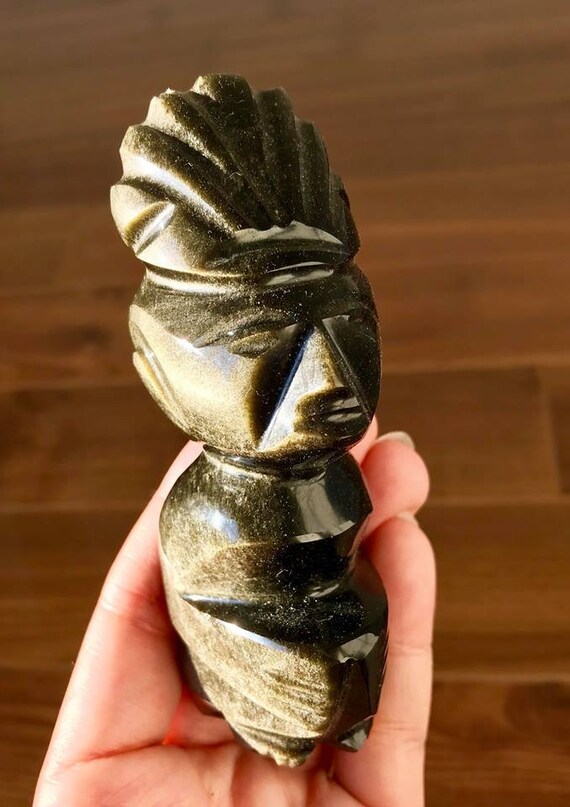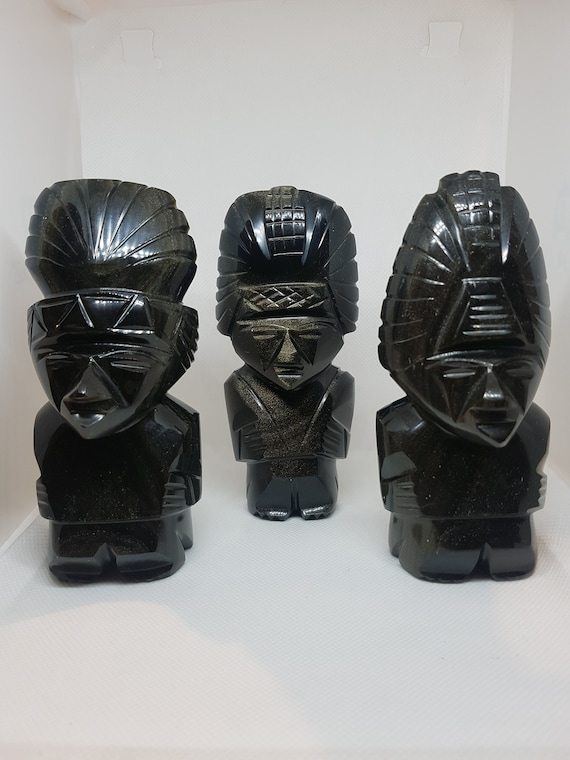The Aztec people that dominated central Mexico around the 15th century are often depicted as brutal and bloodthirsty – a reputation apparently reinforced by the recent discovery of a 'tower of human skulls'. Yet, as Caroline Dodds Pennock explains, this doesn't tell the whole story of a society that was also caring, artistic and inclusive. Obsidian Puma is an epic tale full of interesting characters. The hero is an Aztec boy named Miztli. His father sends him to the Great Capital of the Aztecs in the hope he.
Obsidian monkey jar from Texcoco
One of the most famous objects in Mexico City’s Museo Nacional de Antropología (National Anthropology Museum) is this exquisite jar, made of obsidian, depicting a monkey holding its tail above its head. Other similar - and larger - pieces exist, made of onyx or other colourful stones, in museums outside Mexico, but this one from Texcoco, just 6 inches high, remains a rare classic. The great Mexican archaeologist and historian Ramón Piña Chan described the piece, 50 years ago in the Museum’s first major catalogue, as ‘one of the most valuable pieces in the museum and an absolute unique model’... (Written by Ian Mursell/Mexicolore)
| Pic 1: Materials for working obsidian, Florentine Codex Book XI, including (from top right) a blade-making tool, blade, obsidian block, grinding stone; the knives on the left are European barbers’ blades perhaps included for comparison (Click on image to enlarge) |
But what is the story behind this exceptional Mexica vessel, depicting a ‘stylised monkey, as smoothly polished as a mirror’?
The Spanish recognised the supreme skill of Aztec lapidaries (precious stone workers) very soon after arriving in the New World. The skill of working prismatic obsidian blades had in fact first developed in Mesoamerica, among the Olmec, some 2,500 years prior to the Spanish invasion, remaining largely unchanged in all that time and based on a hard volcanic glass that scholars have since called ‘the steel of the New World’. The Spanish friar Juan de Torquemada, in his Monarquía Indiana (1615) admired ‘workmen who still make knives of a certain black stone or flint, which it is a most wonderful and admirable thing to see... the ingenuity which invented this art is much to be praised.’ He noticed that the technique used involved splitting off pieces of obsidian using the force of pressure rather than the more percussive method of knapping the raw block with a harder stone. Polishing was generally accomplished with abrasives including sand, a piece of cane, and/or water mixed with powdered stone or flint.
| Pic 2: Steps in making a stone effigy vessel - here the example is travertine, a form of massive calcium carbonate. Drawing by Elbis Domínguez, from ‘Ancient Mexican Art at Dumbarton Oaks’ (Click on image to enlarge) |
Some clues into just how these fine stone vessels were made - and how complex it was - comes from finding unfinished examples. Javier Urcid outlines the stages involved: ‘Raw material was extracted from its matrix by cutting a block with strings. The next step involved finishing the exterior features, regardless of whether the vessels were plain or decorated. This step required techniques such as cutting, drilling, grinding, chiseling, pecking, and polishing. Once the exterior was completed, the artisans carved out the vessels with tubular hollow drill bits made from animal long bones and reeds or perhaps with solid bits made of hard wood... Finishing involved chiselling, pecking, grinding, smoothing and polishing the scars left by the drilling.’
| Pic 3: The long coiled tail carved in relief on the monkey’s back suggests the animal represented is a spider monkey. Replica (Click on image to enlarge) |
Though several monkey effigy vessels are known, only one comes from a funerary offering, leaving scholars guessing as to the main purpose of these pieces; one thing is certain, though - they were only made for members of the élite. And why a (spider) monkey? Urcid suggests this may relate to ‘the saga of a failed creation, in which monkeys featured importantly, before the advent of true humans, or perhaps it alludes to the playful character of the patron deities of artisans.’
| Pic 4: Little is known of the meaning or function of these vessels as the iconography is so simple (Click on image to enlarge) |
The Aztecs’ love of stones of different colours and shiny surfaces, such as obsidian and onyx marble, out of which they made a range of sculptures, containers and jewellery, led, however, to complications centuries later in the art world, since, as Esther Pasztory explains, ‘these pieces became favourite collectors items for Westerners in the nineteenth century for their precious material, generally small size, and beautiful carving; the market for such pieces led to the making of forgeries, which still continues...’
It was, unsurprisingly perhaps, in the 19th century that we first pick up the story of the famous obsidian vessel in the spotlight here. It arrived in Mexico’s National Museum in 1880, was catalogued as having come from ‘an ancient tomb, found in the grounds of an hacienda near Tezcoco’, was photographed first in 1891, and was the subject of an article written in 1884 by the French collector and archaeologist Eugene Boban, who claimed that a Dr. Rafael Lucio had obtained the piece in 1869 after spotting it in the home of a patient of his.

| Pic 5: The place glyph for Ytzucan, ‘Place of Obsidian’, Codex Mendoza fol. 42r (Click on image to enlarge) |


The patient had apparently ‘bought the object from a peasant farmer who found it on an hacienda, in exchange for a sheep “worth 12 reales”’. According to Boban, the good doctor, aware of the value of the piece and to salve his conscience, gave his patient a diamond ring the next day. He later sold it to the Museo Nacional ‘for a bargain, so it could remain in the country where it was made’. Jane Walsh, who researched this story, suspects that Boban was somehow involved in assessing the value of the object, which would explain his intimate knowledge of the conversations and deal between Lucio and the campesino. We know that Boban was not only highly knowledgeable on the subject of the value and whereabouts of Mexican antiquities at the time, but also of the existence of numerous fake pieces, including obsidian ones, hailing from the small town of San Juan Teotihuacán. He later wrote, rather cryptically, that the ancient Mexicans ‘never made figures or idols of obsidian’, concentrating their work mainly on masks, jewellery and adornments, concluding ‘all obsidian objects with body, arms and legs can be considered fakes’. No-one, though, is suggesting this almost-too-perfect-to-be-true piece is anything other than ‘the real deal’; or are they? Actually, yes! Follow the link below to see who...
| Pic 6: Obsidian blades and other artefacts, Templo Mayor Museum, Mexico City (Click on image to enlarge) |


Sources consulted:-
• Walsh, Jane M. (2004) ‘La Vasija de Obsidiana de Texcoco’, Arqueología Mexicana vol. XII, no. 70, 66-67
• Pastrana, Alejandro (2006) ‘La Obsidiana en Mesoamérica’, Arqueología Mexicana vol. XIV, no 80, 49-54
• Pasztory, Esther (1983) Aztec Art, Harry N. Abrams, New York
• Ramírez Vázquez, Pedro et al (1968) The National Museum of Anthropology, Mexico, Harry N. Abrams, New York
• Urcid, Javier (2010) ‘Valued Possessions: Materiality and Aesthetics in Western and Southwestern Mesoamerica’ in Ancient Mexican Art at Dumbarton Oaks (Ed. Susan Toby Evans), Dumbarton Oaks Research Library, Washington, 191-199
• Heyden, Doris (1991) ‘Dryness Before the Rains: Toxcatl and Tezcatlipoca in To Change Place: Aztec Ceremonial Landscapes (Ed. Davíd Carrasco), University Press of Colorado, 188-202
• Tylor, Edward B. (1861) Anahuac Longman, Green, Longman and Roberts, London
• Florentine Codex. Book 11 - Earthly Things (1963) trans. by Charles E. Dibble & Arthur J.O. Anderson, School of American Research and University of Utah, Santa Fe, New Mexico
• Bray, Warwick (1968) Everyday Life of the Aztecs, Dorset Press, New York.
| Pic 7: The drawings of the monkey effigy vessel in an 1885 article by Eugene Boban in the journal ‘Revue d’ethnographie’ (Click on image to enlarge) |
Picture sources:-
• Main pic: photo by Ana Laura Landa/Mexicolore
• Pic 1: image from the Florentine Codex (original in the Biblioteca Medicea Laurenziana, Florence): images scanned from our own copy of the Club Internacional del Libro 3-volume facsimile edition, Madrid, 1994
• Pic 2: image scanned from Valued Possessions... (see Urcid, Javier, above)
• Pix 3, 4 & 6: photos by Ian Mursell/Mexicolore
• Pic 5: image from the Codex Mendoza (original in the Bodleian Library, Oxford) scanned from our own copy of the James Cooper Clark facsimile edition, London, 1938
• Pic 7: image downloaded from last link below.
This article was uploaded to the Mexicolore website on Apr 04th 2018
Obsidian Aztec Mother Of Pearl Statue
“See and Be Seen: (‘Smoking’) Mirrors” - learn more about obsidian and the Mexica
Aztec Obsidian Spear
‘The “Skull of Doom of Lubaantun” and other spectacular forgeries’ - scroll to bottom of page...
